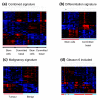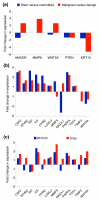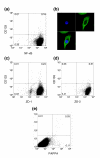Gene expression profiling of human prostate cancer stem cells reveals a pro-inflammatory phenotype and the importance of extracellular matrix interactions
- PMID: 18492237
- PMCID: PMC2441469
- DOI: 10.1186/gb-2008-9-5-r83
Gene expression profiling of human prostate cancer stem cells reveals a pro-inflammatory phenotype and the importance of extracellular matrix interactions
Abstract
Background: The tumor-initiating capacity of many cancers is considered to reside in a small subpopulation of cells (cancer stem cells). We have previously shown that rare prostate epithelial cells with a CD133+/alpha2beta1hi phenotype have the properties of prostate cancer stem cells. We have compared gene expression in these cells relative to their normal and differentiated (CD133-/alpha2beta1low) counterparts, resulting in an informative cancer stem cell gene-expression signature.
Results: Cell cultures were generated from specimens of human prostate cancers (n = 12) and non-malignant control tissues (n = 7). Affymetrix gene-expression arrays were used to analyze total cell RNA from sorted cell populations, and expression changes were selectively validated by quantitative RT-PCR, flow cytometry and immunocytochemistry. Differential expression of multiple genes associated with inflammation, cellular adhesion, and metastasis was observed. Functional studies, using an inhibitor of nuclear factor kappaB (NF-kappaB), revealed preferential targeting of the cancer stem cell and progenitor population for apoptosis whilst sparing normal stem cells. NF-kappaB is a major factor controlling the ability of tumor cells to resist apoptosis and provides an attractive target for new chemopreventative and chemotherapeutic approaches.
Conclusion: We describe an expression signature of 581 genes whose levels are significantly different in prostate cancer stem cells. Functional annotation of this signature identified the JAK-STAT pathway and focal adhesion signaling as key processes in the biology of cancer stem cells.
Figures






References
Publication types
MeSH terms
Substances
Grants and funding
LinkOut - more resources
Full Text Sources
Other Literature Sources
Medical
Research Materials

